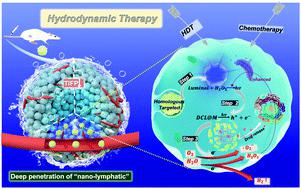当前位置:
X-MOL 学术
›
Mater. Horiz.
›
论文详情
Our official English website, www.x-mol.net, welcomes your feedback! (Note: you will need to create a separate account there.)
“Nano-lymphatic” photocatalytic water-splitting for relieving tumor interstitial fluid pressure and achieving hydrodynamic therapy
Materials Horizons ( IF 13.3 ) Pub Date : 2020-10-10 , DOI: 10.1039/d0mh01295e Cong Cong 1, 2, 3, 4, 5 , Cheng Rao 5, 6, 7, 8, 9 , Zhenhe Ma 4, 10, 11, 12 , Menghan Yu 4, 10, 11, 12 , Yaqian He 1, 2, 3, 4, 5 , Yuchu He 1, 2, 3, 4, 5 , Zining Hao 1, 2, 3, 4, 5 , Chunhui Li 1, 2, 3, 4, 5 , Hongming Lou 5, 6, 7, 8, 9 , Dawei Gao 1, 2, 3, 4, 5
Materials Horizons ( IF 13.3 ) Pub Date : 2020-10-10 , DOI: 10.1039/d0mh01295e Cong Cong 1, 2, 3, 4, 5 , Cheng Rao 5, 6, 7, 8, 9 , Zhenhe Ma 4, 10, 11, 12 , Menghan Yu 4, 10, 11, 12 , Yaqian He 1, 2, 3, 4, 5 , Yuchu He 1, 2, 3, 4, 5 , Zining Hao 1, 2, 3, 4, 5 , Chunhui Li 1, 2, 3, 4, 5 , Hongming Lou 5, 6, 7, 8, 9 , Dawei Gao 1, 2, 3, 4, 5
Affiliation

|
The advancement of anti-tumor nanomedicines is restricted by the delivery efficiency owing to a lack of insight into the intratumoral delivery mechanism, especially traversing the biological barriers. Herein, we explore a new strategy focusing on controlling excessive high tumor interstitial fluid pressure (TIFP) caused by lymphatic lack, which hampers the convective diffusion of nanomedicines to the tumor center. We construct a “nano-lymphatic” system (DOX/g-C3N4/luminol@cytomembrane, DCL@M) based on graphitic carbon nitride (g-C3N4) for photocatalytic water splitting, which can decrease the volume of the tumor interstitial fluid to ameliorate the transfer resistance derived from the high TIFP. In the tumor microenvironment, lactic acid as a sacrificial agent in catalysis greatly promoted the water-splitting efficiency; thus, TIFP in the tumor tissue was reduced to 62.11%, causing an enhancement in blood perfusion to the tumor. The accumulation of the “nano-lymphatic” system (16.73%) in the tumor was 15.9- and 3.31-fold greater than those of free doxorubicin hydrochloride (DOX, 1.05%) and DOX/g-C3N4@cytomembrane (DC@M, 3.03%), respectively. The penetration efficiency of the “nano-lymphatic” system was 8.98% at the tumor center. The “nano-lymphatic” strategy produced reactive oxygen species associated with water splitting to suppress the tumor growth; thus, we define the strategy as hydrodynamic therapy, which provides a new avenue for nanomedicines in traversing biological barriers and achieves a better therapeutic effect.
中文翻译:

“纳米淋巴”光催化水分解可减轻肿瘤间质液压力并实现水动力疗法
由于缺乏对肿瘤内递送机制的了解,特别是穿越生物屏障,抗肿瘤纳米药物的进展受到递送效率的限制。本文中,我们探索了一种新的策略,重点在于控制由于淋巴管缺乏引起的过度高的肿瘤间质液压力(TIFP),这会阻碍对流扩散纳米药物到肿瘤中心。我们基于石墨氮化碳(gC 3 N 4)构建了一个“纳米淋巴”系统(DOX / gC 3 N 4 / luminol @ cytomembrane,DCL @ M))进行光催化水分解,可减少肿瘤组织液的体积,以改善源自高TIFP的转移阻力。在肿瘤的微环境中,乳酸作为催化作用的牺牲剂,大大提高了水的分解效率。因此,肿瘤组织中的TIFP降低至62.11%,导致血液向肿瘤的灌注增加。“纳米淋巴”系统(16.73%)在肿瘤中的蓄积比游离阿霉素盐酸盐(DOX,1.05%)和DOX / gC 3 N 4的蓄积分别大15.9和3.31倍@细胞膜(DC @ M,3.03%)。“纳米淋巴”系统在肿瘤中心的穿透效率为8.98%。“纳米淋巴”策略产生了与水分解相关的活性氧,从而抑制了肿瘤的生长。因此,我们将策略定义为水动力疗法,这为纳米药物穿越生物屏障提供了新途径,并取得了更好的治疗效果。
更新日期:2020-11-03
中文翻译:

“纳米淋巴”光催化水分解可减轻肿瘤间质液压力并实现水动力疗法
由于缺乏对肿瘤内递送机制的了解,特别是穿越生物屏障,抗肿瘤纳米药物的进展受到递送效率的限制。本文中,我们探索了一种新的策略,重点在于控制由于淋巴管缺乏引起的过度高的肿瘤间质液压力(TIFP),这会阻碍对流扩散纳米药物到肿瘤中心。我们基于石墨氮化碳(gC 3 N 4)构建了一个“纳米淋巴”系统(DOX / gC 3 N 4 / luminol @ cytomembrane,DCL @ M))进行光催化水分解,可减少肿瘤组织液的体积,以改善源自高TIFP的转移阻力。在肿瘤的微环境中,乳酸作为催化作用的牺牲剂,大大提高了水的分解效率。因此,肿瘤组织中的TIFP降低至62.11%,导致血液向肿瘤的灌注增加。“纳米淋巴”系统(16.73%)在肿瘤中的蓄积比游离阿霉素盐酸盐(DOX,1.05%)和DOX / gC 3 N 4的蓄积分别大15.9和3.31倍@细胞膜(DC @ M,3.03%)。“纳米淋巴”系统在肿瘤中心的穿透效率为8.98%。“纳米淋巴”策略产生了与水分解相关的活性氧,从而抑制了肿瘤的生长。因此,我们将策略定义为水动力疗法,这为纳米药物穿越生物屏障提供了新途径,并取得了更好的治疗效果。



























 京公网安备 11010802027423号
京公网安备 11010802027423号